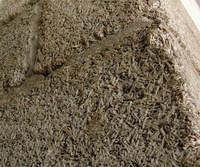What does it mean to be green? Not too many months ago I visited a village in the Western Cape that has an eco-friendly home under construction. It also had no geysers, no electricity, hardly any plumbing and less than half a roof. Made of cob, it was all very interesting, but I came away thinking there would be no cold beer at the end of the day.
The truly green house is not connected to any grid. It collects its own water and generates its own energy. It also disposes of its own waste. It may even be carbon neutral or positive, selling excess clean energy into the central grid.
But it would be exceedingly costly and difficult -- stupid even -- to attempt such a house at present in the South African urban environment.
City homes can aim to be sustainable, though, if they are designed to minimise both inputs and outputs. They can aim to maximise efficiencies so that running costs are low, as is waste output.
Sustainable homes aim to limit negative effects on the environment by using local and natural materials, recycled items and local products and services. They aim to be low maintenance and maximise energy efficiency by good orientation to the sun and using effective insulation...
Some websites offer online checklists where you can score your home in terms of how sustainable it is. But these are usually of limited value as what makes sense in Europe, for instance, is unlikely to be suitable for Johannesburg. In the north heating is the main thing, in the south cooling may be as, or more, important...
Cement
The house has used a lot of cement, a natural product with almost magical building properties, but one that takes vast amounts of electricity to produce. Along the way I found out that by-products of industrial processes, such as fly ash or slag, can be used as extenders, reducing the cement content in each bag by up to 34%.
All cement bags are labelled to reflect this, you just have to know how to decode the label.
There is also a lot of embodied energy in the steel used to make windows, doors and stairs and to support three slabs.
The house is nearing completion. It will harvest rainwater, recycle grey water (from the washing machine and showers, but not from the dishwasher), it will use natural gas for space heating and hot water, lighting will be low-wattage and where there are large sections of glass, safety glass will be used which has better insulation properties. It will have a closed firebox linked to water-based under floor heating. An outbuilding will have a sod roof.
In the United Kingdom the market for ethical goods and services, at £29-billion, now exceeds that for cigarettes and alcohol, according to a recent report.
In Cape Town there appears to be an active market in green building products and services. In Gauteng there is none.
I have learned from this project that if there is an eco-consciousness in this country it is in Cape Town.
As far as Gauteng is concerned, Noah's flood could be coming, we don't know it and we don't care. M&G Kevin's Ark
The truly green house is not connected to any grid. It collects its own water and generates its own energy. It also disposes of its own waste. It may even be carbon neutral or positive, selling excess clean energy into the central grid.
But it would be exceedingly costly and difficult -- stupid even -- to attempt such a house at present in the South African urban environment.
City homes can aim to be sustainable, though, if they are designed to minimise both inputs and outputs. They can aim to maximise efficiencies so that running costs are low, as is waste output.
Sustainable homes aim to limit negative effects on the environment by using local and natural materials, recycled items and local products and services. They aim to be low maintenance and maximise energy efficiency by good orientation to the sun and using effective insulation...
Some websites offer online checklists where you can score your home in terms of how sustainable it is. But these are usually of limited value as what makes sense in Europe, for instance, is unlikely to be suitable for Johannesburg. In the north heating is the main thing, in the south cooling may be as, or more, important...
Cement
The house has used a lot of cement, a natural product with almost magical building properties, but one that takes vast amounts of electricity to produce. Along the way I found out that by-products of industrial processes, such as fly ash or slag, can be used as extenders, reducing the cement content in each bag by up to 34%.
All cement bags are labelled to reflect this, you just have to know how to decode the label.
There is also a lot of embodied energy in the steel used to make windows, doors and stairs and to support three slabs.
The house is nearing completion. It will harvest rainwater, recycle grey water (from the washing machine and showers, but not from the dishwasher), it will use natural gas for space heating and hot water, lighting will be low-wattage and where there are large sections of glass, safety glass will be used which has better insulation properties. It will have a closed firebox linked to water-based under floor heating. An outbuilding will have a sod roof.
In the United Kingdom the market for ethical goods and services, at £29-billion, now exceeds that for cigarettes and alcohol, according to a recent report.
In Cape Town there appears to be an active market in green building products and services. In Gauteng there is none.
I have learned from this project that if there is an eco-consciousness in this country it is in Cape Town.
As far as Gauteng is concerned, Noah's flood could be coming, we don't know it and we don't care. M&G Kevin's Ark






1 comment:
Yes, Cape Town is the place. I saw a John Vlismas skit where he was doing Gautengers telling God to hang on a minute when the apocalypse came so they could finish doing business on their cellphones.
Post a Comment